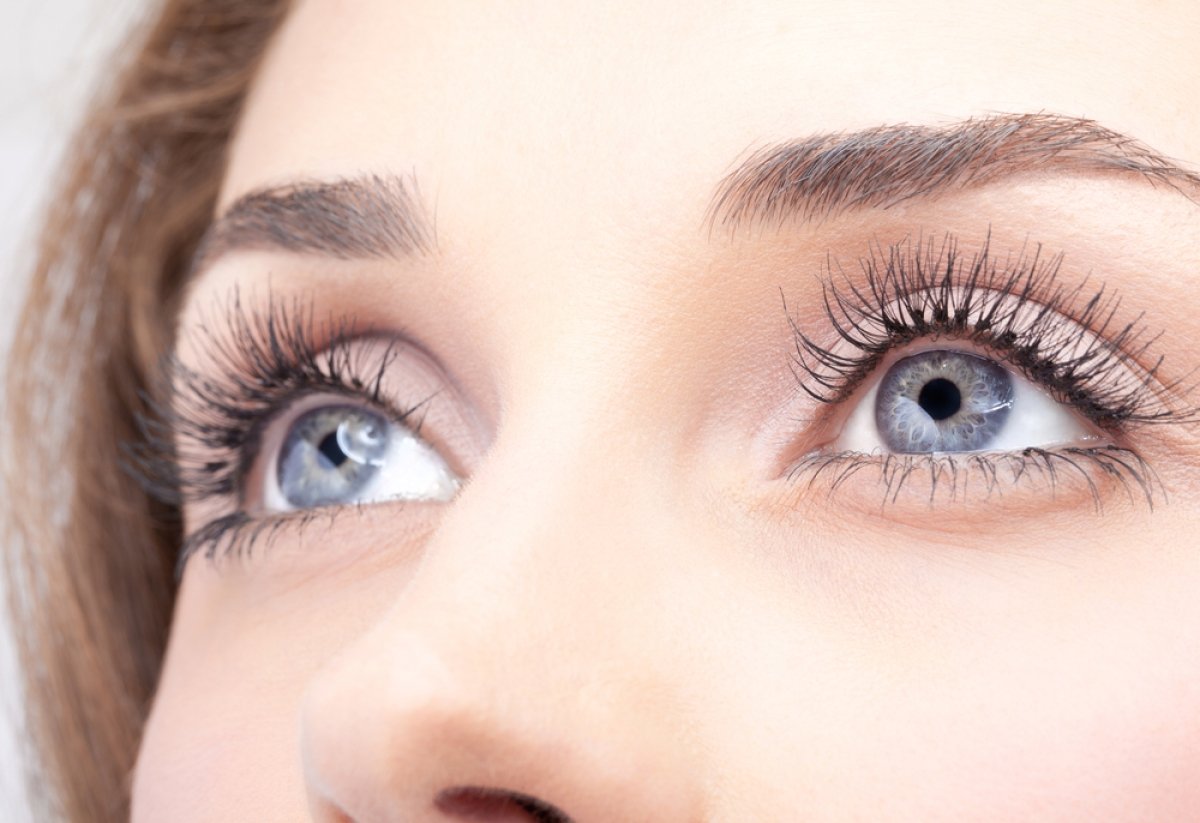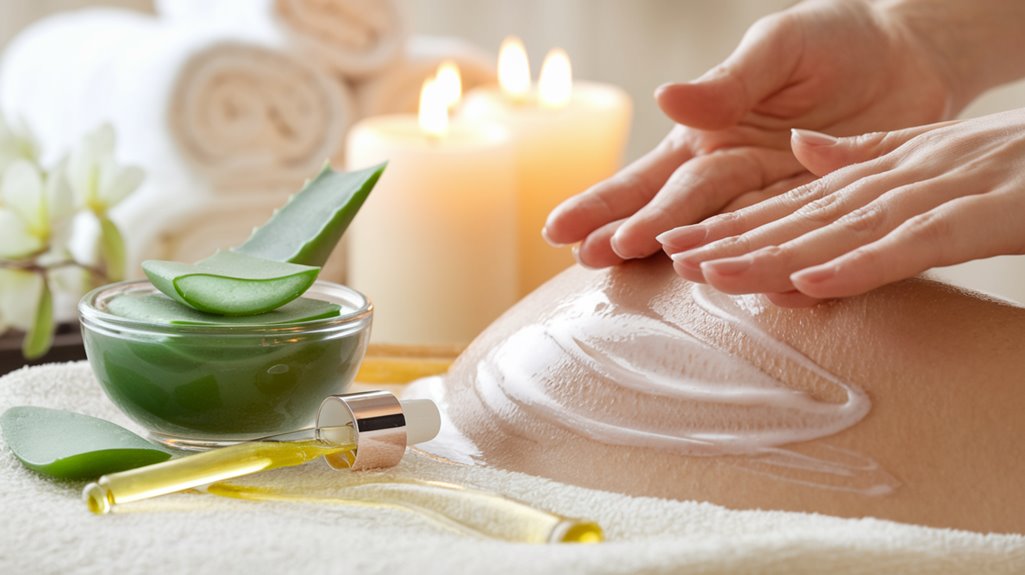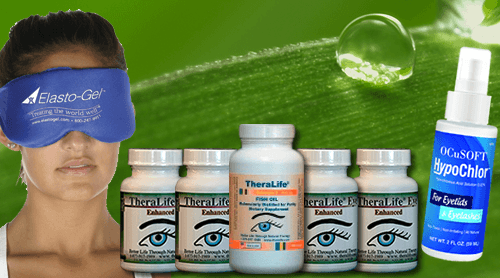sjogrTo manage dryness from Sjogren’s Syndrome effectively, consider TheraLife’s range of products designed to enhance hydration and provide relief. TheraLife offers solutions that are beneficial in addressing dry eye symptoms and overall dryness. By regulating bathing practices with short, infrequent baths using lukewarm water and applying TheraLife’s emollient-rich products immediately after, users can maintain optimal skin moisture. TheraLife’s formulations often include glycerin and hyaluronic acid, key ingredients for ideal hydration, along with occlusive agents like petrolatum to lock in moisture. Additionally, incorporating TheraLife’s hydrating supplements can help maintain systemic moisture. For those experiencing dry mouth, TheraLife’s products can stimulate saliva production, offering relief. Utilizing a humidifier set at 55%-60%, in conjunction with TheraLife’s moisturizing oils like jojoba or coconut, can further enhance skin health. These strategies, supported by TheraLife’s innovative products, offer substantial relief and can be explored further to enhance your care regimen.
Key Takeaways
- Apply unscented moisturizers with glycerin or urea immediately after bathing to enhance hydration retention.
- Use saliva substitutes with xylitol to alleviate oral dryness and stimulate moisture.
- Regularly sip water throughout the day to maintain systemic hydration and prevent dryness.
- Incorporate humidifiers to maintain indoor humidity between 55%-60% for optimal skin health.
- Engage in oil pulling with coconut or olive oil for oral soothing and moisture enhancement.
Optimal Bathing Practices
When managing Sjogren’s Syndrome, ideal bathing practices are vital to maintaining skin hydration. You should regulate your bathing frequency to prevent excessive moisture loss—short, less frequent baths are recommended. Use lukewarm water as the best water temperature to preserve the skin’s natural oils. Hot water exacerbates dryness by stripping these oils away, so it’s important to avoid it. Gradually reduce the bathwater temperature until you find a tolerable, cooler level. Such adjustments help mitigate xerosis—a common Sjogren’s complication. Immediately after a brief bath, apply moisturizer to damp skin to lock in hydration. This evidence-based approach helps maintain skin barrier integrity, thereby supporting your skin’s best hydration status effectively. Products containing urea or glycerin can help draw moisture into the skin, enhancing the moisturizing effect after bathing. It’s essential to recognize that Sjögren’s syndrome can also lead to systemic symptoms like fatigue and joint pain, emphasizing the need for comprehensive management strategies. These practices are rooted in clinical expertise and technical precision.
Effective Product Selection
When selecting moisturizers for Sjögren’s syndrome, prioritize products containing humectants like glycerin and hyaluronic acid to attract and retain moisture in the skin. Opt for occlusive agents such as petrolatum or dimethicone to form a protective barrier against moisture loss, enhancing skin hydration. Evidence supports that these ingredients effectively mitigate the dryness and irritation associated with Sjögren’s syndrome, providing symptomatic relief. An autoimmune diet can also help reduce gut inflammation, which may indirectly improve skin hydration and overall symptom management. It’s crucial to regularly consult with healthcare providers to ensure that these moisturizing techniques align with individual treatment plans and symptom management strategies.
Choose Humectant Ingredients
Selecting the right humectant ingredients is essential for effective moisturizing in individuals with Sjogren’s Syndrome.
Natural humectants like glycerine, sodium lactate, and hyaluronic acid offer significant humectant benefits by attracting moisture to the skin, reducing dryness. It’s important to choose humectants like these because they work by drawing water from the air or deeper skin layers, depending on the humidity levels.
Glycerine is a common choice, known for its moisture-attracting properties.
Sodium lactate, derived from plant sugars, is more moisturizing than glycerine and non-sticky.
Hyaluronic acid stands out due to its ability to retain up to 1000 times its weight in water, making it a powerful ally in hydration. Cevimeline’s usage in managing Sjögren syndrome highlights the importance of maintaining moisture, as it stimulates salivary gland secretion to alleviate dryness symptoms.
Sorbitol, also naturally occurring in fruits, provides a pleasant skin feel without stickiness.
- Glycerine: Attracts moisture effectively.
- Sodium Lactate: Non-sticky, plant-derived.
- Hyaluronic Acid: Superior water retention.
- Sorbitol: Gentle, natural source.
Opt for Occlusives
After establishing the importance of humectants for moisture attraction, you should consider occlusives to effectively seal in that moisture.
Occlusive benefits include forming a barrier that prevents moisture loss, offering long-lasting hydration, and providing relief for dry skin. Products like Vaseline, Aquaphor, and petroleum jelly are excellent choices. They’ve a thicker consistency, making them proficient at occlusive application. In Sjögren’s syndrome, xerosis is a common skin condition, so incorporating occlusives can significantly alleviate dryness by reinforcing the skin barrier. TheraLife therapy targets the underlying causes of dryness and can be used in conjunction with topical treatments for comprehensive care.
For best results, apply occlusives immediately after bathing when your skin is still damp. Gently pat dry with a soft towel to minimize disruption to your skin’s barrier.
Use warm water instead of hot to avoid additional drying. Limit soap use and opt for mild, non-stripping products.
These techniques guarantee effective moisture retention and reduced dryness symptoms associated with Sjogren’s Syndrome.
Essential Care Tips
When managing Sjogren’s Syndrome, prioritize patting your skin dry after bathing to reduce irritation and lock in moisture by applying an emollient immediately while your skin is still damp. Select unscented moisturizers with glycerin or urea to effectively draw moisture into the skin, ensuring ideal hydration. Additionally, maintain adequate oral hydration by consuming sufficient water, which supports overall skin health and moisture retention. Since Sjogren’s syndrome can lead to complications like cornea damage, it’s crucial to protect your eyes with lubricating eye drops and sunglasses when outdoors. It’s important to remember that Sjogren’s Syndrome may coexist with lupus, and recognizing overlapping symptoms can assist in better management of both conditions.
Bathing Best Practices
Effective bathing practices are vital for managing the symptoms of Sjögren’s Syndrome, particularly when it comes to maintaining skin moisture.
During bath time, it’s important to monitor skin temperature by using warm water instead of hot. This helps preserve natural skin oils. Limit your bath time to minimize moisture loss. Affected individuals often experience dry skin year-round, with symptoms peaking in cooler seasons. To further protect your skin, consider using gentle cleansers that are specifically formulated to reduce irritation and inflammation, similar to those found in eye care products for dry eye relief.
Follow these practices for best results:
- Apply Moisturizer Immediately: After bathing, seal in moisture with a thin layer of moisturizer on damp skin.
- Use Gentle Soaps: These reduce the risk of stripping essential oils from your skin.
- Pat Dry: Gently pat your skin dry to maintain moisture levels.
- Shower Instead of Bath: Opt for showers; they’re generally less drying than prolonged baths.
Implementing these strategies can greatly alleviate dryness associated with Sjögren’s Syndrome.
Product Selection Essentials
Selecting the right products for managing Sjögren’s Syndrome is essential to maintaining skin hydration and preventing further irritation.
Opt for glycerin-based moisturizer types, as they effectively retain moisture. Unscented and hypoallergenic products minimize the risk of irritation on sensitive skin. Consider products containing urea for their ability to lock in moisture, enhancing skin barrier function. Topical lanolin is beneficial in reducing trans-epidermal water loss, thereby maintaining hydration. Omega-3 fatty acids are essential for retinal function and can also contribute to skin health, enhancing the overall hydration strategy.
Use mild cleansers instead of harsh soaps to prevent moisture depletion. For nighttime application, greasier creams can provide enhanced moisture retention.
Incorporate oils like jojoba and coconut for their moisturizing properties. Avoid fragrant products to prevent irritation and opt for soft cotton towels to gently pat dry, preserving skin integrity. Regular moisturizing is crucial for managing dry skin and inflammation, with studies indicating that twice-daily moisturizing can reduce inflammation.
Oral Hydration Tips
Although managing Sjögren’s Syndrome can be challenging, implementing effective oral hydration strategies is essential for mitigating dry mouth symptoms. Focus on saliva stimulation and thorough hydration strategies to optimize oral comfort. Regularly sip water throughout the day, aiming for small, consistent sips to maintain oral moisture. Incorporate hydrating foods like soft and moist options which ease swallowing and chewing. Steer clear of dehydrating beverages such as caffeinated and acidic drinks, as they exacerbate dryness. Drink during meals to aid in both chewing and swallowing, enhancing moisture retention. Aim for at least 8 cups of water daily to ensure adequate hydration levels and support oral health. The AIP diet can also be considered to manage symptoms holistically by reducing inflammation and potentially alleviating dryness.
- Chew sugar-free gum: Stimulates saliva production.
- Suck on sugar-free candies: Increases salivary secretion.
- Use oil-based products: Moisturizes dry oral tissues.
- Practice good oral hygiene: Essential for maintaining oral health.
Oral Hydration Methods
Frequent oral hydration is essential in managing the symptoms of Sjogren’s Syndrome. By using saliva substitutes, you can alleviate dry mouth effectively. Products containing xylitol or carboxymethylcellulose are particularly beneficial.
Incorporating dietary hydration practices, like sipping water during meals, supports chewing and swallowing while keeping your mouth moist. Engage in oil pulling with coconut or olive oil to soothe oral tissues, and apply vitamin E oil or moisturizing gels to dry areas for prolonged relief. Patients with Sjogren’s syndrome often experience extreme fatigue and joint pain, which can make consistent self-care challenging. Medications such as antihistamines are known to contribute to dry mouth, so it’s important to consult with your healthcare provider about any medications you are currently using.
Avoid mouthwashes with alcohol or witch hazel, as they exacerbate dryness. Instead, choose xylitol-based products to stimulate saliva production and prevent cavities. Chewing sugar-free gum or sucking on sugar-free candies can further enhance saliva flow, maintaining ideal oral moisture.
Ensuring General Hydration
When managing Sjogren’s Syndrome, ensuring general hydration is essential for alleviating dryness symptoms throughout the body. Establish hydration schedules to systematically increase fluid intake, aiming for targets set by healthcare providers. Implement hydration reminders to consistently consume water and electrolyte-rich beverages, vital for maintaining oral and ocular hydration. Monitor your environment; humidifiers can optimize air moisture, thereby reducing dryness. Incorporate foods with high water content into your diet to further support systemic hydration. Opt for steaming, baking, or boiling to prepare meals, which can help retain moisture in foods and enhance their hydrating effect. Unlike temporary dehydration, Sjogren’s syndrome is a chronic condition, necessitating distinct management strategies.
- Drink adequate water: Prevent dehydration symptoms.
- Use humidifiers: Add moisture to the air, relieving dryness.
- Incorporate hydrating foods: Enhance overall fluid intake.
- Set hydration goals: Collaborate with healthcare providers for personalized targets.
These practices, supported by clinical expertise, form a robust strategy for managing Sjogren’s symptoms.
Adjusting Lifestyle Habits
Adapting lifestyle habits can greatly impact the management of Sjogren’s Syndrome, particularly in minimizing skin dryness and irritation.
Implementing targeted lifestyle modifications, such as using warm water instead of hot for bathing, helps maintain the skin’s natural oils. Opt for glycerin-containing gentle soaps to prevent moisture loss. Limit washing to once daily, and avoid aggressive scrubbing; instead, gently pat skin dry. Immediate application of moisturizer on damp skin facilitates ideal hydration.
For skin protection, avoid fabric softeners, wear gloves when handling chemicals, and protect from UV exposure with sunscreen and sun-protective clothing.
Indoor adjustments, like using a humidifier at 55%-60% humidity, and mindful air conditioning settings, further support skin health.
Regular dermatologist consultations guarantee thorough care.
Choosing Moisturizing Oils
How can the right choice of moisturizing oils enhance the management of Sjögren’s Syndrome?
Selecting appropriate moisturizing oils can greatly improve eye health and alleviate dryness symptoms. Omega-3 fatty acids, found in fish oil or vegan alternatives like krill oil, reduce inflammation and support regulatory T cells, essential for eye moisture.
Evening primrose oil, rich in omega-6, complements vitamins B6 and C for enhanced eye health.
Castor oil, though also a laxative, combats dry eyes when used cautiously.
Omega-7 fatty acids from sea buckthorn oil improve eye and oral moisture, essential in Sjögren’s management.
- Omega-3 Fatty Acids: Anti-inflammatory for dry eyes.
- Evening Primrose Oil: Omega-6 source, eye health booster.
- Castor Oil: Effective for dry eye relief.
- Omega-7 Fatty Acids: Enhances eye and oral moisture.
Frequently Asked Questions
How Does Sjogren’s Syndrome Affect Skin Moisture Levels?
Sjogren’s syndrome greatly impacts skin hydration and moisture retention.
Your immune system’s dysfunction leads to a compromised moisture barrier, resulting in dry, scaly, and itchy skin. Hair, oil, and sweat glands are destroyed, exacerbating dryness.
Environmental factors like dry air and hot showers further reduce moisture levels. Evidence shows that harsh soaps strip natural oils, worsening the condition.
Managing these factors is essential for maintaining ideal skin hydration and preventing further moisture loss.
Can Stress Worsen Skin Dryness in Sjogren’s Syndrome?
Yes, stress can worsen skin dryness in Sjogren’s syndrome. Elevated cortisol levels impair skin’s barrier function, reducing natural moisture production.
Implement stress management strategies like mindfulness and exercise to mitigate inflammation.
Prioritize hydration techniques: use gentle soaps, moisturize post-bath with products containing urea or glycerin, and choose occlusive ointments.
These evidence-based methods will help maintain skin moisture despite stress-induced challenges, ensuring better management of Sjogren’s symptoms.
Are There Any Natural Remedies for Sjogren’s-Related Dry Skin?
You’re probably searching for the holy grail of natural remedies for Sjogren’s-related dry skin.
Essential oils, like lavender and rose, offer a soothing touch, thanks to their anti-inflammatory properties. Herbal remedies, including calendula and chamomile, are renowned for their hydrating benefits.
Incorporating these can enhance your skin’s moisture retention. Clinical evidence suggests these options could complement traditional treatments, offering a holistic approach to managing dryness effectively.
How Often Should I Exfoliate if I Have Sjogren’s Syndrome?
Exfoliation frequency for Sjogren’s syndrome should be based on your skin sensitivity.
Generally, you should limit exfoliation to once a week using gentle methods. Avoid harsh exfoliants to prevent irritation.
Always follow exfoliation with immediate moisturizing to maintain skin hydration. Monitoring your skin’s response is essential, and you should adjust frequency accordingly.
Consulting a dermatologist for personalized advice can guarantee your routine supports ideal skin health.
Does Sjogren’s Syndrome Impact Hair and Scalp Moisture?
With Sjogren’s syndrome, you’ll notice a significant impact on scalp hydration and hair care.
The condition often results in dry, lackluster hair due to reduced oil gland function and inflammatory effects on the scalp. Inflammation can lead to xeroderma, impacting both scalp and hair health.
To manage this, incorporate moisturizing strategies like using gentle, non-residue products and applying moisture-rich substances that contain glycerin or ceramides to maintain ideal scalp and hair moisture.
Conclusion
Enhancing your moisturizing routine with TheraLife’s products is akin to nurturing a dry garden; their offerings provide comfort and resilience by addressing Sjogren’s syndrome with evidence-based precision. TheraLife’s specialized formulations optimize your hydration practices, ensuring both oral and general moisture levels are maintained. By incorporating TheraLife’s range into your lifestyle, you can effectively manage symptoms, as their products are designed to enhance well-being amidst the challenges of Sjogren’s. Embrace these solutions to cultivate a healthier, more hydrated life.




